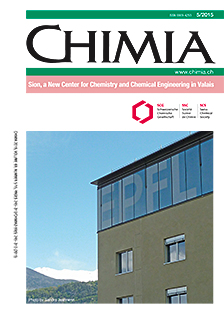Storage of Renewable Energy by Reduction of CO2 with Hydrogen
DOI:
https://doi.org/10.2533/chimia.2015.264Keywords:
Co2 reduction, Energy storage, Hydrides, Hydrogen, Synthetic fuelsAbstract
The main difference between the past energy economy during the industrialization period which was mainly based on mining of fossil fuels, e.g. coal, oil and methane and the future energy economy based on renewable energy is the requirement for storage of the energy fluxes. Renewable energy, except biomass, appears in time- and location-dependent energy fluxes as heat or electricity upon conversion. Storage and transport of energy requires a high energy density and has to be realized in a closed materials cycle. The hydrogen cycle, i.e. production of hydrogen from water by renewable energy, storage and use of hydrogen in fuel cells, combustion engines or turbines, is a closed cycle. However, the hydrogen density in a storage system is limited to 20 mass% and 150 kg/m3 which limits the energy density to about half of the energy density in fossil fuels. Introducing CO2 into the cycle and storing hydrogen by the reduction of CO2 to hydrocarbons allows renewable energy to be converted into synthetic fuels with the same energy density as fossil fuels. The resulting cycle is a closed cycle (CO2 neutral) if CO2 is extracted from the atmosphere. Today's technology allows CO2 to be reduced either by the Sabatier reaction to methane, by the reversed water gas shift reaction to CO and further reduction of CO by the Fischer–Tropsch synthesis (FTS) to hydrocarbons or over methanol to gasoline. The overall process can only be realized on a very large scale, because the large number of by-products of FTS requires the use of a refinery. Therefore, a well-controlled reaction to a specific product is required for the efficient conversion of renewable energy (electricity) into an easy to store liquid hydrocarbon (fuel). In order to realize a closed hydrocarbon cycle the two major challenges are to extract CO2 from the atmosphere close to the thermodynamic limit and to reduce CO2 with hydrogen in a controlled reaction to a specific hydrocarbon. Nanomaterials with nanopores and the unique surface structures of metallic clusters offer new opportunities for the production of synthetic fuels.Downloads
Published
2015-05-27
Issue
Section
Scientific Articles
License
Copyright (c) 2015 Swiss Chemical Society

This work is licensed under a Creative Commons Attribution-NonCommercial 4.0 International License.
How to Cite
[1]
Chimia 2015, 69, 264, DOI: 10.2533/chimia.2015.264.







